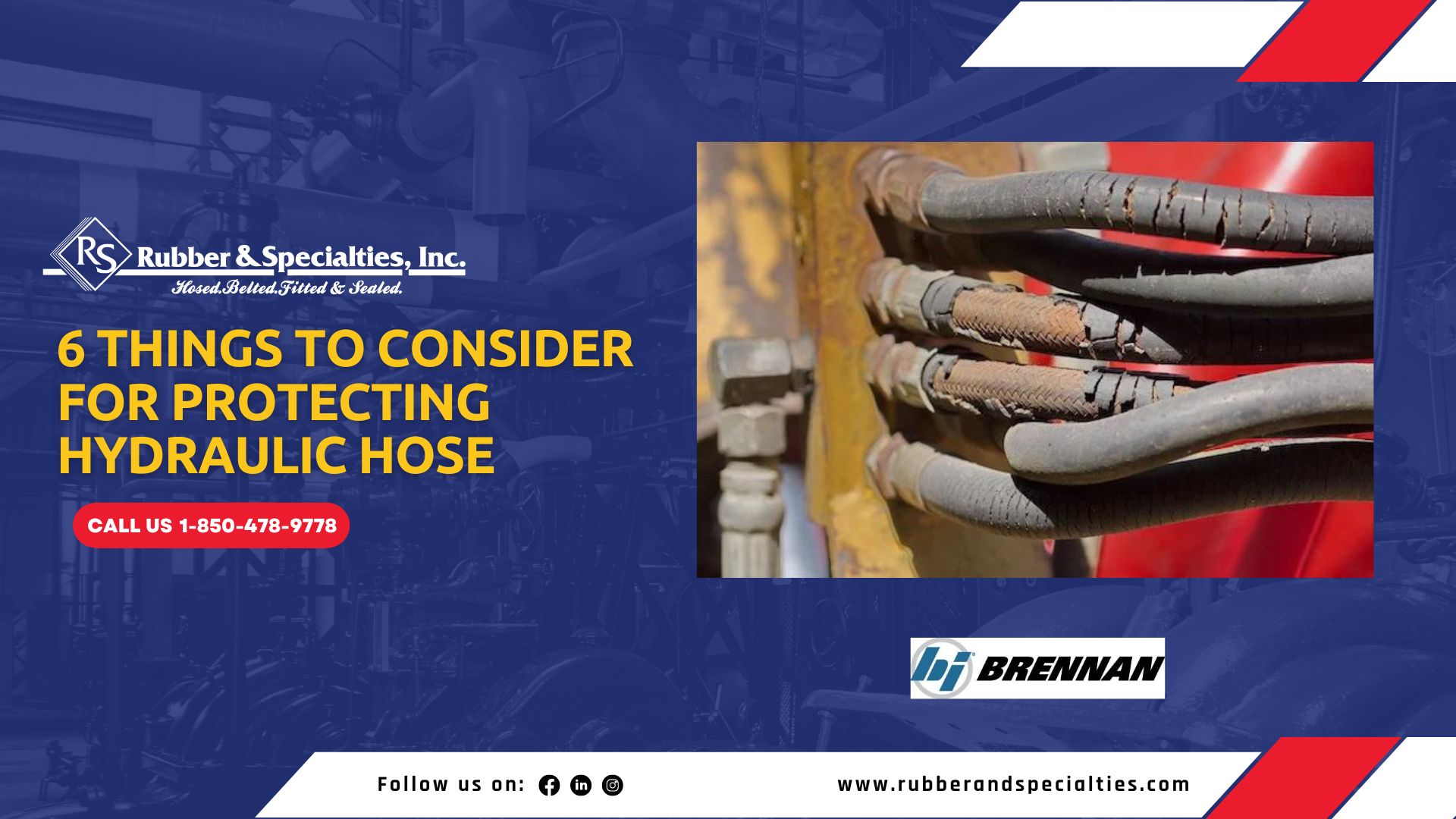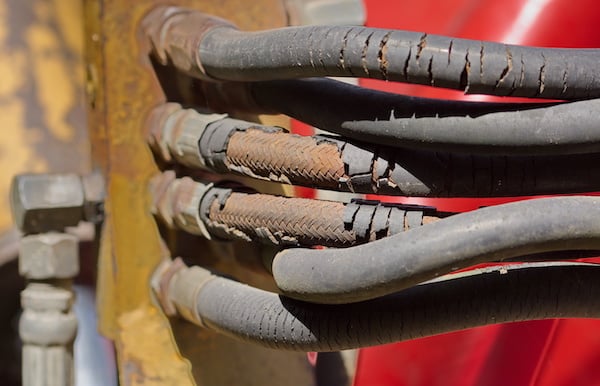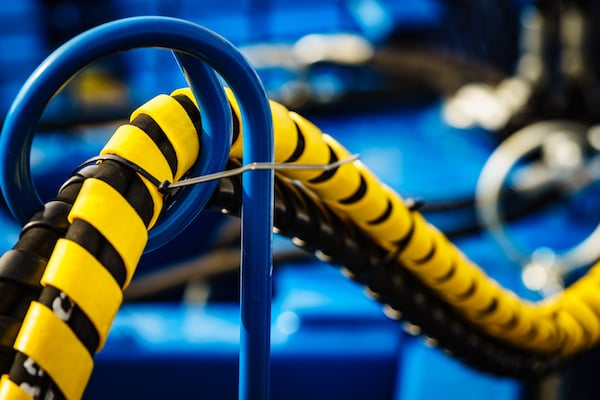
6 Things to Consider for Protecting Hydraulic Hose
NAHAD, The Association for Hose and Accessories Distribution, has chosen the week of September 10th as Hose Safety Awareness Week. This week is set aside to bring special attention to hose safety and how hydraulic professionals can reexamine safety methods in design, development and application reliability to extend system service life and ensure users of their products are safe.
For many businesses, from construction to agriculture, manufacturing, transportation, automotive, aerospace and more, hydraulic equipment keeps systems running. One of the most frequently used (and one of the most vital) system components is the hydraulic hose, which is also the most susceptible to failure without proper handling and safeguards. If a hose fails, it can inflict severe injury and cause expensive downtime. Hoses fail for many reasons- the most common is likely old age. However, some of today’s hydraulic hoses can endure up to a million impulse cycles with proper care.
The most common safety issues with hoses are caused by leaks. Fluid leaks from a high-pressure hydraulic hose can be very dangerous, causing slip hazards, hydraulic injection injury to the skin (the most common and dangerous injury), and the potential of fire and environmental contamination. Leaking hoses can be the result of improper installation, abrasion with other hose or metal edges, hose burst from exceeding pressure ratings or worn outer covers, and exposure to high temperatures. Those working with hydraulic hoses should be skilled at anticipating and preventing problems- and fixing them before they occur.
The Dangers of Hose Failure
On April 30, 2021, aboard a fishing vessel off the coast of Massachusetts, a hydraulic hose failed, leading to a fire in the engine room. Marine Investigation Report 22/13 details the National Transportation Safety Board’s investigation into the fire aboard the fishing vessel Nobska. The NTSB determined the fire was caused by a hydraulic hose burst that sprayed fluid onto a hot surface, perhaps the engine exhaust pipe, and quickly engulfed the vessel in flames. Fortunately, the crew members were rescued by a U.S. Coast Guard helicopter and there were no reports of injury. However, the vessel was completely destroyed, causing an estimated loss of $2.4 million. The incident would likely never have occurred had the hose been properly protected from fluid spray after bursting.
Hydraulic Hose Safety Measures
There are a number of safety products and procedures for protecting hydraulic hoses, including:
- Hose abrasion occurs when the outer cover wears away, exposing the reinforced braided or spiral steel wires and ultimately leading to fluid leaks or hose burst. Abrasion can be prevented by using hoses that meet the requirements of the application, such as maintaining the specified material, diameter and length. If multiple hoses are run together and repeatedly flex in the same direction, such as in the boom of a backhoe, it’s important to bundle them by using a 1050 ballistic nylon hose wrap, zip-ties, clamps or spring guards.
- Use hose sleeves to keep hose away from abrasive sources and to protect against fluid and pinhole leaks caused by hose failure when the system becomes over pressurized. The hydraulic hose sleeving captures and contains fluid that escapes from a hose bursting or a pinhole leak.
- Spring guards are corrosion-resistant, wound steel springs used as a protective cover for hydraulic hoses. They are available in various diameters and serve to provide protection against cuts, crushing, abrasion, deep gouges, accidental compression and impact from other machinery components. Spring guards protect the hose while flexing. They are frequently used in the harsh conditions experienced with construction equipment.
- Spiral Guard wraps protect hoses from UV light, abrasion, cuts, crushing and other hazards which can damage hydraulic hose lines. As the name implies, spiral wraps are easy to install on loose hose and existing assemblies without the need to disconnect lines. Their strong, flexible and lightweight construction with beveled edges for safety make them ideal for a wide variety of hose safety applications. Additionally, larger sizes are typically intended for the extra protection needed when bundling multiple hose lines.
- A common area of failure is where the hose meets the fitting. Bend Restrictors reduce bending stresses near the hose coupling junction. They increase hose safety by protecting sleeves and guards. Their main purpose, however, is to restrict the bend at or near the coupling where it’s held securely in place by its upper lip attached to the coupling. This eliminates the need for clamps or adhesives. Bend restrictors are frequently used with various types of hydraulic and pressure-wash hoses, where there is a tendency for recurrent movement at the fitting connection.
- Perhaps one of the most important hose safety products are Firesleeves, which protect hydraulic hoses from extreme heat and intermittent flames. Under continuous exposure to heat, these type E fiberglass coated sleeves made of high-grade silicone rubber with an elastomer coating are rated for up to 500°F (260°C). For prolonged exposure of 15 to 30 minutes it can withstand up to 2000°F (1093°C) and for brief periods of 15 to 30 seconds it will hold up at 3000°F (1650°C). Firesleeves are resistant to fuels, lubricating oils and hydraulic fluids. Their heavy-duty industrial design insulates against energy loss and protects workers from burns. They’re also available in diameters large enough to allow for hose bundling.
Conclusion
More often than not, hose safety comes down to common sense. For experienced hydraulic system design engineers and maintenance personnel, knowing what conditions the hose will operate under and preparing for those conditions are an everyday part of the job. However, that doesn’t mean that failures will not inadvertently occur. Consider these tips to help avoid failures and be sure to attach and run the hose as specified by the manufacturer. This will ensure your hoses are properly protected by sleeves or wraps; and restrained and supported by brackets and/or hangars.
Never ignore a damaged outer hose jacket. The jacket prevents moisture from attacking the steel wire reinforcement- which, if exposed, will lead to corrosion and eventual failure. It’s imperative to follow hose safety procedures to ensure personal safety and a long system service life.
Sources Include:

